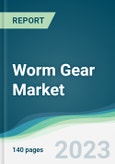The global worm gear market is estimated to grow at a CAGR of 3.81% during the forecast period.
A worm gear is a type of gear consisting of a threaded shaft that when engaged with a gearwheel creates and transfers rotary motion between shafts. The location of the worm on the worm gear alters the 90-degree rotation and the plane of motion. Worm gears are utilized in a wide range of applications, including consumer goods, heavy machinery, and industrial applications. They are highly high reduction ratio producers and frequently self-locking despite their low efficiency.Market Drivers:
Growing number of escalator drive systems.
Worm reduction gearboxes have become more and more common in several swiftly growing end-use sectors. Worm helical gear units have a proven track record as escalator drive units on a global scale. Various public transit initiatives undertaken by governments substantially increase the need for escalators. High-speed worm gear unit stages provide the best noise-absorbing properties while ensuring a low-noise torque gearbox which increases the worm gear market share in the automotive sector.Low-noise application and minimal space
The worm gear market size is anticipated to expand owing to its high-performance features. Owing to their incredibly silent operation, they are suitable for areas where noise is a concern. Spur gears and other gears, on the other hand, frequently make high-pitched whines and other sounds, especially when moving quickly. In public areas like theatres and airports, worm gears are widely employed. Their small size and minimum space requirements make worm gears effective in applications where there is limited space. They may be utilized, for instance, in conveyors and other compact pieces of machinery.Capacity to generate a high-reduction ratio
Worm gears' capacity to achieve high reduction ratios and therefore significant torque multiplication is their main advantage They can also be used as speed reducers in low and medium-speed applications. Because their reduction ratio only depends on the number of gear teeth, they are also smaller than other types of gear. Worm gears are excellent for hoisting and hauling applications as they self-lock, like fine-pitch lead screws. Combining sliding and rolling motions, the worm and gear mesh at large reduction ratios, with sliding contact predominating.Rising use for material handling
Worm gears are highly used for material handling. The vast array of products is created to carry out efficient material handling with shorter overall cycle times. Major key players in this market are offering products with features that significantly improve the efficiency of material handling, including high reliability, longevity, mounting flexibility, robustness, and compactness. The broad variety of products covers both interior and exterior material handling which is increasing the worm gear market share. For instance, Top Gear provides a modular design for a wide variety of planetary-geared motor variations appropriate for many industrial applications.North America is projected to dominate the worm gear market
During the projected period, the North American region is anticipated to lead the worm gears market owing to the bolstering growth of major end-users such as aerospace and medical. The rising demand for material-handling systems, like conveyors is increasing in North America which is leading to market growth. Favorable investments by major North American nations namely the United States and Canada in the expansion of their airports and the construction of new ones to accommodate the growing air passenger traffic have provided a positive market scope for worm gear elevator applications.Market Challenge:
Worm gear lubrication
A worm gear's primary issue is the way it transfers power. If normal helical gears are employed, the helical motion provides for a significant reduction in the amount of area needed in a relatively small location. As the major form of power transmission, this spiraling motion also results in a very troublesome situation. This is frequently referred to as sliding wear or sliding friction. Power is transferred, at least under rolling wear circumstances, at the highest load point on the teeth of a conventional gear set. Both sides of the apex experience sliding, but only at slow speeds which impedes the worm gear market.Company Products
- Atlas Gear Company provides worm gears with a 36" diameter and eight starters. They produce worm gears from a variety of materials, such as bronze, plastics, metals such as stainless steel, malleable and cast irons, and steel alloys, for several functions. They can match the worm and gear exactly as they will be mounted in the gearbox with their Illinois Model 2324 Worm Gear Tester. This enables us to precisely match the tooth-bearing contact and confirm that the backlash meets the required standards.
Segmentation:
By Type
- Non-Throated
- Single Throated
- Double Throated
By Mounting Type
- Keyway Mounting
- Set Screw Mounting
- Split Mounting
By Application
- Elevators
- Gates & Conveyor Belts
- Rolling Mills
- Material Handling
- Others
By Geography
- North America
- United States
- Canada
- Mexico
- South America
- Brazil
- Argentina
- Others
- Europe
- United Kingdom
- Germany
- France
- Spain
- Others
- Middle East and Africa
- Saudi Arabia
- UAE
- Israel
- Others
- Asia Pacific
- China
- Japan
- India
- South Korea
- Indonesia
- Thailand
- Others
Table of Contents
1. INTRODUCTION
2. RESEARCH METHODOLOGY
3. EXECUTIVE SUMMARY
4. MARKET DYNAMICS
5. WORM GEARS MARKET BY TYPE
6. WORM GEARS MARKET BY MOUNTING TYPE
7. WORM GEARS MARKET BY APPLICATION
8. WORM GEARS MARKET BY GEOGRAPHY
9. COMPETITIVE ENVIRONMENT AND ANALYSIS
10. COMPANY PROFILES
Companies Mentioned
- The Adams Company
- Gear Motions
- Atlas Gear Co.
- B. V. Transmission Industries
- AmTech OEM
- Precision Gears, Inc.
- TS HENSCHEL GmbH
Methodology

LOADING...








